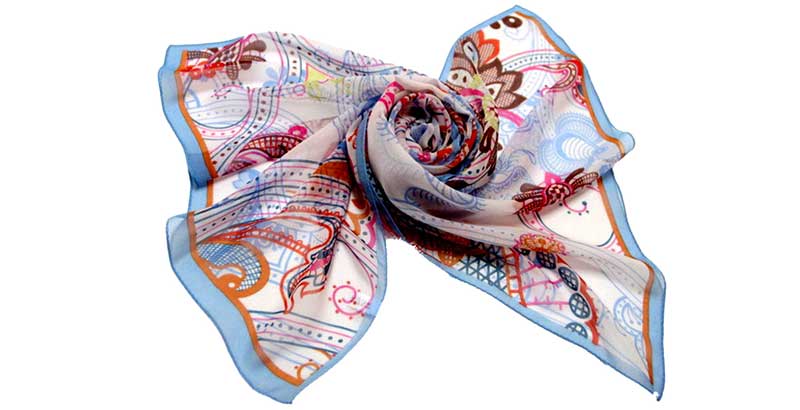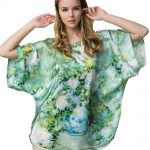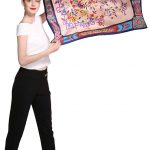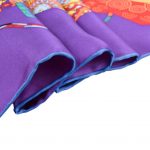History of Silk Fabric – A Timeline Shrouded in Mystery
Hold a luxurious silk scarf to your face, enjoying the singular smoothness of your colorful treasure. Do you know that you’re holding 5,000 years of history in your hands? From alluring legend to a sustained 2,000 year-old secret, the mysterious history of silk fabric could take up hundreds of pages of a good book. Here are the highlights of its origins, trade, and fame throughout the ages.
In the Beginning – 3,000 BC
It all began with a cup of tea.
Legend has it that Empress Hsi-Ling-Shih, wife of Emperor Huang Ti (The Yellow Emperor), was the first person to discover silk as a fiber. Enjoying a cup of tea, seated under a mulberry tree, as the smells of spring in China rose up to meet her royal nostrils, a silkworm cocoon fell into her cup. Upon her surprise, she looked down into her tea and watched with wonder as the cocoon unraveled into a long, shimmering white thread.
Intrigued by the gossamer structure forming in her cup, she hunted for the source – the Bombyx mori silkworm. She soon developed sericulture, or the cultivation of silkworms, and also invented the reel and loom. Whether or not the legend is true, ancient silk artifacts prove that silk production started more than 5,000 years ago, and so our story begins.
The Secret Survives – 1400 BC
By the 14th century BC, silk was a booming industry in China. From bowstrings and robes to luxury paper, the Chinese loved this very central part of their economy. In fact, silk was so precious to the Chinese that they would execute anyone caught trying to smuggle eggs, cocoons, or silkworms out of the country. Because of this death penalty, the art of sericulture remained a secret for almost three thousand years.
Losing the Monopoly – 200 BC – 550 AD
200 BC marks the time when China started to lose its grip on its proudly kept, silky secret. At this time, a large number of brave people migrated from China to Korea, carrying with them the forbidden secret of sericulture. Slowly, the art of silk production would travel throughout Asia. By 300 AD, sericulture had traveled westward and silkworm cultivation was adapted in India.
Traveling the Silk Road – 550 AD
Although the secret of sericulture had been gradually leaked for centuries, two Nestorian monks took it upon themselves in 550 AD to bring silk to the Byzantine Empire. Risking the threat of pushing silk production further into the Western world, they hid silkworm eggs in their hollow bamboo staves as they approached the court of Justinian I, the Byzantine Emperor. Because of this singular event, Byzantium was officially in the silk trade, and quickly established silk production in the Middle East.
However, the Middle East still acknowledged that Chinese silk textiles were superior in quality, bringing about the necessity of the famed Silk Road. Trade boomed along this route between China and the Mediterranean Sea, leading to discovery of silk production by the Persians in the 6th century.
13th Century AD
The time of the Second Crusades marks Italy’s mastery of silk production with the introduction of 2,000 silk weavers from Persia. Italian silk soon became a prized source of the fabric, as it is still today. Italian silk was so popular throughout Europe, in fact, that Francis I of France invited Italian silk artisans to create a French silk industry that rose to fruition in the 17th century.
Sericulture Today
Unfortunately, the 19th century saw the downfall of European silk and Chinese silk. Cheaper Japanese silk became popular after the opening of Suez Canal, as did manmade fiber such as nylon. However, after the Second World War, Japan’s silk production made a comeback, and, after a time, China gradually won back the role as the world’s biggest silk producer. Currently about 125,000 metric tons of silk is produced in the world, and two-thirds of that is produced in China.
To those of us at Grace Scarves, the history of silk fabric is a love story. We carry forth the tradition of 100% Chinese silk by distributing only the finest textiles from top manufacturers in China. Browse our selection of colorful silk scarves, clothing, and household goods today to seize your own piece of the story.






Comments by Grace
Asian Silk Scrolls – 5 Ways A Silk Scroll Can Transform Any Room
"Kathleen, this scroll sounds like a very valuable piece of..."
The Real Silk Scarf Test – A Surefire Way to Test the Quality of Your Silk
"Thank you for your question and your interest in our..."